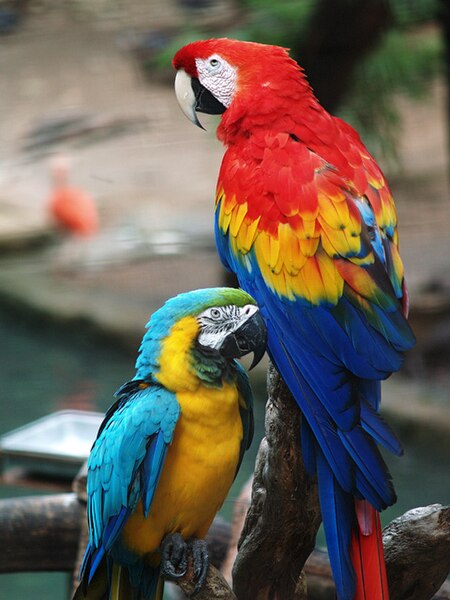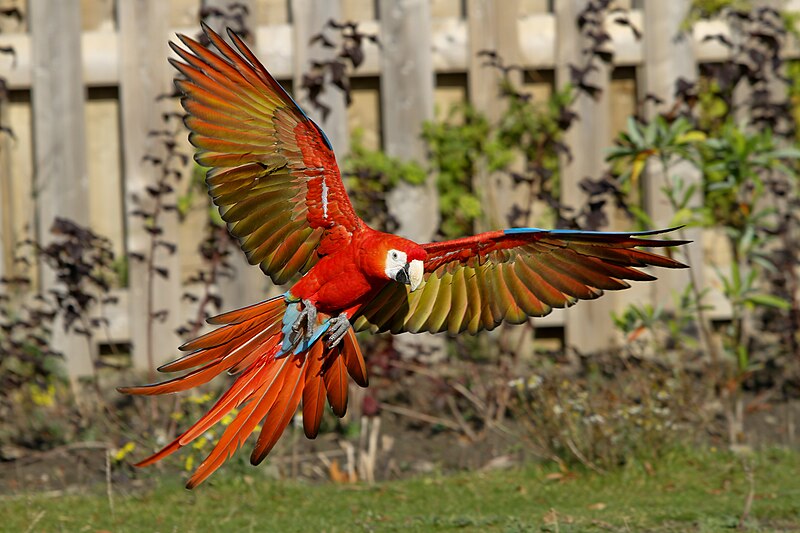Macaws in a store or the wild draw the eye instantly – loud, gorgeous, active and intelligent, they are the ultimate parrot pets in the eyes of many hobbyists. Indeed, when prices were lower, a macaw was often the first parrot purchased by those new to the hobby.
Some Preliminary Considerations
However, these strong-willed birds are not for everyone, and certainly not for those without some parrot-keeping experience. More so than their relatives, macaws are prone to “bullying” their owners. They learn very quickly, and once they believe dominance has been attained, can be quite a handful. With massive beaks capable of exerting up to 300 pounds per square inch of pressure, they are not to be taken lightly. Most species are large and loud, and require a great deal of room. All must be kept busy…a bored macaw soon becomes a destructive and impossible pet.
That being said, a hand-raised macaw in the right situation is an unparalleled pet – affectionate, intelligent and talkative in ways that few birds can match.
Range and General Characteristics
Macaws comprise a group of 6 genera and 17 species, classified with all other parrots in the family Psittacidae. Five species are recently extinct and a sixth, the glaucous macaw (Anodorhynchus glaucus), may be so. The little blue or Spix’s macaw (Cyanopsitta spixii) no longer occurs in the wild but holds on in captivity. Ranging throughout Central and South America and Mexico, populations of all are considered to be at risk.
The giant of the group, the hyacinth macaw (Anodorhynchus hyacinthinus) is also the world’s largest parrot. Awe-inspiring to behold, hyacinths reach 40 inches in length, and sport wingspans of nearly 5 feet. At a “mere” 12 inches, the noble or red-shouldered macaw (Ara nobilis) is the smallest species.
Choosing a Species
A number of macaw species have been bred in captivity and, despite superficial similarities, they can differ greatly as to their suitability as pets. I’ll write detailed articles about individual species in the future, but would now like to present a general overview. When observing macaws, please bear in mind that hybrids are quite common in the pet trade, and they may differ markedly from either parent species.
The Noble or Red-Shouldered Macaw, Ara nobilis
 This smallest of the macaws makes up in personality what it lacks in size. Indeed, it is quite difficult to distinguish its bold, confident attitude from that of the much larger species. Although a small macaw, the noble is still a substantial parrot, and, given its active and inquisitive nature, requires a huge cage and plenty of exercise. It is, however, a bit less prone to aggression than other macaws, and well-habituated individuals make delightful, if often noisy, companions.
This smallest of the macaws makes up in personality what it lacks in size. Indeed, it is quite difficult to distinguish its bold, confident attitude from that of the much larger species. Although a small macaw, the noble is still a substantial parrot, and, given its active and inquisitive nature, requires a huge cage and plenty of exercise. It is, however, a bit less prone to aggression than other macaws, and well-habituated individuals make delightful, if often noisy, companions.
A Well-Known Subspecies
A subspecies, known as Hahn’s macaw (A. n. cumanensis) is one of the most widely-bred of the group, and is considered to be a fairly easy bird to train. This and its small size make the Hahn’s an ideal choice for the first-time macaw owner. Both noble and Hahn’s macaws have attained ages in excess of 50 years in captivity, and could potentially live a good deal longer.
Noble Macaws in the Wild
Noble macaws range from Guyana, Suriname and French Guiana through eastern Venezuela to southern Brazil. They frequent lightly-forested areas, but flee to deep cover when threatened. Forest-fringed savannas, palm groves, wooded farms and plantation edges are typical haunts. Noble macaws are most frequently encountered in groups of up to 10 birds, with pairs being evident by their interactions.
Despite their brilliant coloration, these green and red birds are surprisingly difficult to pick out among tree branches. This, combined with their unusual quietness while feeding, affords protection from both human and natural enemies.
During my time in Venezuela, I twice missed out on seeing flocks noticed by sharper-eyed colleagues. Once they take to the wing, however, noble macaws are very loud and very fast…so I wound up barely glimpsing them, but with a good earful!
A detailed article on breeding noble and other small macaws in captivity, presented at the Canadian Parrot Symposium, is posted at:
http://www.silvio-co.com/cps/articles/1996/1996worth1.htm
Please also see my article Brief Notes on Wild Scarlet Macaws (Ara macao) in Venezuela.
Image referenced from Wikipedia and first posted by Snowmanradio.
 Many parrot enthusiasts view macaws as the ultimate avian pets. Huge, personable, gorgeous and enormously intelligent, macaws seem to embody all that is desirable in a pet parrot. However, macaw ownership is not to be undertaken lightly…while the rewards are great, there are many responsibilities and “downsides” to consider as well.
Many parrot enthusiasts view macaws as the ultimate avian pets. Huge, personable, gorgeous and enormously intelligent, macaws seem to embody all that is desirable in a pet parrot. However, macaw ownership is not to be undertaken lightly…while the rewards are great, there are many responsibilities and “downsides” to consider as well. That Bird Blog – Bird Care and History for Pet Birds
That Bird Blog – Bird Care and History for Pet Birds


 The Scarlet Macaw (Ara macao) is surely one of the most recognizable birds on the planet. Images of this spectacular parrot adorn the brochures and T-shirts of travel agencies, zoos and aviaries worldwide. Less well-known, however, is its natural habits and precarious existence in the wild.
The Scarlet Macaw (Ara macao) is surely one of the most recognizable birds on the planet. Images of this spectacular parrot adorn the brochures and T-shirts of travel agencies, zoos and aviaries worldwide. Less well-known, however, is its natural habits and precarious existence in the wild. This smallest of the macaws makes up in personality what it lacks in size. Indeed, it is quite difficult to distinguish its bold, confident attitude from that of the much larger species. Although a small macaw, the noble is still a substantial parrot, and, given its active and inquisitive nature, requires a huge cage and plenty of exercise. It is, however, a bit less prone to aggression than other macaws, and well-habituated individuals make delightful, if often noisy, companions.
This smallest of the macaws makes up in personality what it lacks in size. Indeed, it is quite difficult to distinguish its bold, confident attitude from that of the much larger species. Although a small macaw, the noble is still a substantial parrot, and, given its active and inquisitive nature, requires a huge cage and plenty of exercise. It is, however, a bit less prone to aggression than other macaws, and well-habituated individuals make delightful, if often noisy, companions.